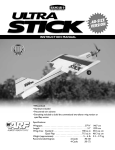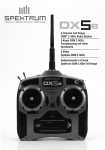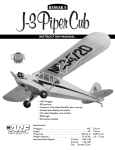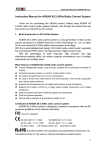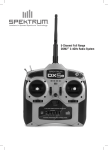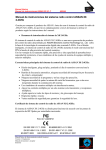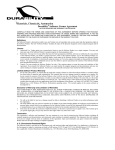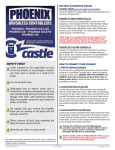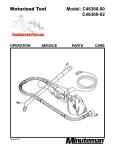Download Spektrum´s DSM (Digital Spectrum Modulation) technology
Transcript
Spektrum´s DSM (Digital Spectrum Modulation) technology Spektrum´s DSM 2.4GHz Spread Spectrum Technology is based on an optimized version of Direct Sequence Spread Spectrum. Spektrum´s DSM and DSM2 technologies provide users with pure digital control, providing an impenetrable radio link that´s immune to interference. Providing exceptional resolution and impressive response times, Spektrum Technology offers RC enthusiasts the accuracy, reliability, and locked in feel necessary to provide a totally connected and crystal-free RC experience. What is DSM? DSM or Digital Spectrum Modulation is Spektrum's proprietary method of implementing 2.4GHz spread spectrum technology for the R/C industry. DSM divides the 2.4Ghz band into 80 individual channels (frequencies) and incorporates direct sequence spread spectrum with an imbedded GUID (Globally Unique Identifier) code. DSM has been painstakingly optimized by our engineers for R/C surface and aircraft use, offering the most robust RF link in the industry. What makes Spektrum Technology a reality is a combination of two factors: the utilization of a frequency in the higher 2.4GHz frequency band and Direct Sequence DSM (Digital Spectrum Modulation) technology. Moving to a broadcast channel in the 2.4GHz range moves the broadcast signal up beyond the range of model generated noise from motors and vibrations. This is the first step in eliminating glitching and interference. From here, unlike current narrow band 27 and 75MHz systems, Spektrum´s Direct Sequence Spread Spectrum (or DSSS) spreads the data over a wide range of spectrum, which helps to minimize narrow band interference. The encoded information is broadcast to the receiver with its own Globally Unique Identification number (called GUID). The GUID code is what makes it virtually impossible for any other receiver to recognize the transmitted information. How Spektrum Works Before you can operate a Spektrum-controlled car or plane, you must first bind the receiver to the transmitter or module. Binding is the process of having the receiver recognize the GUID code of the transmitter or module. Every receiver you plan on using with a particular Spektrum radio or module must go through this binding process to allow a receiver to only recognize one specific module. Once a receiver is bound, collision avoidance software prevents a Spektrum-equipped radio from transmitting on a frequency that is already in use. All Direct Sequence Spread Spectrum systems are required by the FCC to incorporate active collision avoidance, making it impossible and illegal for more than one transmission on a single frequency. Spektrum´s AR7000 and AR6000 air receivers feature DuaLink technology. Each receiver features two separate receivers and antennas built into one device. The transmitter transmits on two frequencies simultaneously while the receiver receives and decodes both sets of information. Should one signal be blocked or corrupted or should one receiver malfunction in flight, the other frequency or receiver will take over. DuaLink offers the security of having two radios operating simultaneously on two separate frequencies. This is called dual path redundancy. Regardless of the plane´s orientation, you will still enjoy that same locked-in feeling to your model thanks to DuaLink. ModelMatch prevents you from flying a model while the transmitter has the wrong model selected. When you bind your receiver to a Spektrum DX7 transmitter, the transmitter remembers the specific memory location that you´ve selected for that aircraft´s profile. In the event that you try to fly a specific model with the wrong model memory selected, the transmitter will not broadcast your transmitter inputs until you change to the proper model memory. Since it is transmitter based, ModelMatch works with all Spektrum air receivers when combined with a DX7 Transmitter. Finally, there´s ServoSync. With ServoSync, the DX7 transmitter´s signal is re-sequenced to best suit the type of mixing you select. This comes in handy in a number of applications, such as if you have a dual elevator on your big Extra or a 3-servo CCPM setup on your heli, ServoSync will see to it that those servos working together receive their impulses together. The result is more synchronized servo movement that translates into an undeniable, locked-in feel when you fly. Why use Direct Sequencing Spread Spektrum There are two main broadcast methods that spread spectrum manufacturers can utilize. One format is called Frequency Hopping Spread Spectrum (FHSS). With an FHSS system, the transmitter transmits a narrow band signal and rapidly jumps from one frequency to the next, spending a few milliseconds on each frequency. Originally, Spektrum engineers started their development with FHSS-based systems because they were relatively easy and inexpensive to develop. However, they soon discovered that FHSS had several limitations that would prevent it from being the optimal solution for RC. While more difficult and costly to develop, our engineers began experimenting with Direct Sequence Spread Spectrum (DSSS) and optimized the modulation scheme to overcome critical response and re-link issues. DSSS systems transmit on a single selected frequency but on a very wide band. Only a small portion of that band is used for specially encoded information. In addition, DSSS offers an increase of processing gain for significant improvements in range. With years of development and testing, the DSSS modulation scheme was optimized for RC car and airplane use, and Spektrum´s DSM 2.4GHz Spread Spectrum Technology was born. DSSS provided engineers and hobbyists with the safety, security, and locked-in feeling that is necessary to maintain total and complete control in any vehicle or aircraft What is DMS2 technology Above and beyond the basic features of DSM, there has been a technological breakthrough for both air and surface applications thanks to Spektrum. An updated version of DSM technology referred to as DSM2 (second generation protocol) makes it possible to fly any size model with the convenience, safety, and peace of mind of Spektrum. With DSM2, the total latency of your radio system has been greatly reduced, while the bit-rate has been increased. When combined, these improvements provide hobbyists with a faster and more locked-in feeling when compared to traditional 27MHz, 72MHz, or 75MHz radio systems. DSM2 also provided a new opportunity when separating the two receivers. By providing superior path diversity, the DSM2 receiver can now see a broader RF environment What happens if the band is full (80 users for surface or 40 users for aircraft) and I turn on my transmitter? In the unlikely event that all channels are occupied, the next transmitter will scan the band indefinitely until open channels are available. The transmitter will then acquire the channel(s) and begin transmitting. Only then will the system connect. What happens if two transmitters are on the same frequency? To be FCC legal, all 2.4Ghz devices must incorporate a collision avoidance system that prevents the system from transmitting on an already occupied frequency. The chance of two transmitters occupying the same frequency is highly unlikely. If two transmitters should somehow end up on the same frequency, other safeguards, such as the GUID and proprietary time base coding, will prevent interference. Of course, with the aircraft system, the transmitter is transmitting on two frequencies simultaneously. The odds of two transmitters transmitting on the same two frequencies is even, more unlikely but again, should this happen, other safe guards will prevent interference. How long will my transmitter battery last? The Spektrum module is very efficient and will actually last nearly twice as long as your current 27 or 75MHz system. We can't give a specific time, because it depends on the type of battery you're using, however, an Airtronics M11 with name brand alkalines will operate for over 7 hours with the Spektrum module. We have several Wi Fi systems and Wireless Routers running at our indoor track. How will this effect the Spektrum system? These systems typically operate on the 2.4GHz band and, while they do occupy some of the bandwidth (channels), they must abide by FCC rules and incorporate collision avoidance. So while these systems can reduce the number of potential operators (there are 79 possible), the systems will operate harmoniously and not cause each other interference. What is the range of my DX6? When used in intended parkflyer models, the range is farther than you can see the model to control it. We don't give a specific range because many issues such as signal attenuation due to metallic conductive material in the aircraft has an effect on the overall range. In fact, that is the main reason why the DX6 is limited to parkflyers only. Is Spektrum allowed at car races and flying events? Spektrum was made ROAR, NORCA and IFMAR legal shortly after its introduction and in many sanctioned races like the ROAR off-road Nationals, where over half the field used Spektrum. The AMA (Academy of Model Aeronautics) has certified its use at all AMA fields and events when used as per the manufacturer's instructions (DX6 Park flyers only). In fact, most event directors welcome Spektrum, as it eliminates the issues of frequency management. Do I still need to impound my transmitter at events? While with Spektrum technology there is no need to impound transmitters, some events still require that all transmitters (conventional and Spektrum) be impounded. Do I still need a frequency clip with Spektrum? Because Spektrum selects an unused channel in the 2.4GHz band each time the transmitter is turned on, the need for frequency control is eliminated. However, some flying fields/race tracks may still require a frequency pin to be used to control the number of drivers on the track or pilots in the air at one time. Is it true that using Spektrum will prevent the problems I'm having with interference caused from electric motors and speed controllers in my model? In many instances, yes it will. The radio interference caused by noisy motors, speed controllers, metal rubbing metal, noisy bearings, etc, generates all its interfering noise below 300MHz-right where we've been operating our 72 and 75mHz models. The Spektrum system operates at 2.4GHz, that's 2400mHz and is well above the frequency that model generated noise is on, so the Spektrum system is unaffected. Air Module Systems: What radios are the Spektrum Air Modules compatible with? Three Spektrum Aircraft Modules are available. The JR Module will fit popular JR module-based aircraft radios including the XP8103, XP9303, 10X, 347, 388, PCM10, PCM10S, PCM10SX and the PCM10SXII. Spektrum´s Futaba Compatible Modules fit all versions of the Futaba 7, 9C and 9Z. Spektrum´s MZ Compatible Modules are designed to fit the Futaba 12 and 14MZ radios. Why do I only get 9 channels with JR and 8 Channels with the Futaba Compatible Modules when the transmitter I´m using has 10, 12 or 14 channels? Spektrum Air Modules operate by utilizing the PPM stream output from the transmitter. It´s necessary to place the transmitter in PPM modulation prior to operating the module system. JR´s 9– and 10–channel transmitters output 9 channels in PPM mode while Futaba´s 9, 12 and 14 channel radios output 8 channels in PPM mode. This is new technology. How can I be assured that the Module System will provide a solid interference-free RF link with plenty of range? Actually the RF technology is identical to the technology that is used in Spektrum´s DX7. There are currently thousands of Spektrum DX7 systems in operation with tens of thousands of successful flights in all types of aircraft—the technology is well proven. In fact, our Technical Director John Adams has been specifically testing the Module Systems for over two years, plus we´ve had several Module Systems in the hand of testers for months prior to release. What is the purpose of the AR9000´s Data Port? An optional device called a Flight Log (SPM9540) is available and plugs into this data port. After a flight and before the receiver is powered off, the Flight Log displays RF link performance of the previous flight. Parameters displayed include the number of bit losses of each remote receiver, the number of frame losses (simultaneous bit losses on all receivers) and holds. In addition to this information, the main receiver battery voltage will be displayed. The Flight Log is an important tool that allows you to confirm that your system and installation is optimized and working perfectly. Will Model Match work with the Module System? No. Model Match is a patented feature that prevents a model from being operated using the wrong model memory. Model Match can only be integrated into a dedicated Spektrum transmitter such as the Spektrum DX7. The programming necessary to make Model Match functional must be embedded into the transmitter´s programming. I hear a lot about latency and response time. Supposedly the DX7 is faster than any 72MHz systems. Is the Module System as fast as the DX7? The DX7 is a purpose-built 2.4GHz spread spectrum radio. With the DX7, the stick inputs are directly converted to digital code bypassing the PPM stream. This is the primary reason the DX7 is so fast and responsive. The module system needs to utilize the transmitter´s PPM stream and converts it to the appropriate digital code. Because of this extra processing step, the module system cannot be as fast as a dedicated system. It´s important to remember that the PPM stream is actually faster than PCM. In reality, the latency and response time of the Spektrum Module System is virtually identical to PCM systems. Does the module system transmit on two channels like the DX7? Yes. The Module System features DSM2 technology with DuaLink. When first turned on, the transmitter scans the 2.4GHz band and finds an open channel to broadcast on. The transmitter then scans the band a second time and finds a second open channel and locks onto that channel. Once complete, the Spektrum Air Modules will be transmitting on two channels simultaneously. The receiver scans the band looking for the module´s GUID (Globally Unique Identifier) code and, when found, locks onto both channels. DuaLink provides modelers with dual-path redundancy, offering a level of safety and security unavailable with a single channel, single receiver system. The AR9000 is a different configuration from previous receivers. Can you tell me more about it? The AR9000 has two internal receivers plus one remote receiver. The AR9000 has a minimum of three receivers operating simultaneously; this is called Multi–link technology. An additional fourth remote receiver can be installed in the other remote receiver port for extra redundancy or in critical applications like turbine jets where significant conductive material is present. The AR9000 also features a data port that allows for an optional Flight Log to be plugged in, allowing the RF link performance to be monitored after a flight. I understand the AR9000 has two types of fail-safe? The AR9000 features both Smart Safe and a conventional fail-safe. With Smart Safe, if there is a loss of signal the throttle servo will move to a preset position (idle) while holding the last position command of the other servos. The AR9000 also has conventional programmable fail-safe that drives all servos to their preset position if there is a signal loss. When the signal is regained, complete control is resumed within 4ms. When I install the Module system in my radio, will all of my settings (travel adjust, trims, etc.) need to be changed? No. All programmed settings, adjustments and trims will be identical when switched from a conventional 72MHz module to a Spektrum 2.4GHz module system. Are there any servo limitations? As with all Spektrum systems, any three-wire servo that is currently available is compatible including digital, analog and high current servos. How much current will the module draw? The system is very efficient, with average current draw of about 220mAh. That means a 1500mAh battery will last for nearly 7 hours. What receivers will work with the Module System? All current and future DSM2 aircraft receivers are compatible with the Module System. The only currently available receiver not compatible with the System is the AR6000 parkflyer receiver. Is there anything else I should know before operating the Spektrum Module System? The following points are clearly covered in the manual but need to be followed: Be sure the transmitter is in PPM modulation mode. If necessary, refer to the instructions included with your radio system for details on how to program your transmitter to PPM modulation. Note: The Spektrum Module System will not operate in PCM modulation mode. Never power up the module unless the antenna is connected. Doing so can overload the module´s electronics causing damage to the module. Before operating, the receiver must be bound to the module (see the manual for proper binding instruction). Binding is the process of teaching the receiver the transmitter´s specific GUID (globally unique identifier) code. Binding also sets the fail-safe positions. It´s also recommended that the system be rebound again after radio setup to establish and confirm the desired fail-safe positions. Before each flying session, it´s imperative that you perform a range check to confirm that the system is working properly. When using the Module system with the AR6100 DSM2 microlite 6-Channel Receiver, it´s imperative that this receiver only be flown in parkflyer type models. This includes all types of small electric airplane and mini and micro helicopters. Do not fly the AR6100 receiver in large gas or glow aircraft, as loss of control at extended range due to signal and/or blocking issues can occur. The Module system features DSM2 technology and is compatible will all DSM2 compatible receivers. The module system is not compatible with the AR6000 DSM first generation receiver. DX7 I´ve had some issues using retracts with Spektrum Smart Safe. What is going on? Several customers have experienced an issue using retracts with the DX6 and DX7 radios. The Issue-With the transmitter turned on and the retract switch in the down position, when the receiver is switched on the retract servo momentarily drives to the retracted position (wheels up) for 2-5 seconds and then the servo is driven to the down position. The Cause- Smart safe failsafe drives the servos to their preset failsafe positions for several seconds when the receiver is first turned on during the period that the receiver is making connection with the transmitter. (2-5 seconds) If the preset failsafe position for retracts is in the up position, when the receiver is first turned on the retracts will be driven to the up position until the receiver connect with the transmitter. The Solution- Rebind the system with the retracts in the down position thus setting the failsafe position to up (not down).The when the system is first turned on the retract servo will be driven to the down position until the transmitter connects to the receiver. What is the range of the DX7 and can I fly large-scale airplanes and large gas or glowpowered helicopters with the system? The DX7's range is beyond visual limits allowing even giant scale airplanes and unlimited class sailplanes to be flown to the limits of sight. The AR7000 receiver incorporates a second remotely mounted receiver that sees a slightly different RF environment. This remote receiver is the key that allows sophisticated aircraft of all sizes and types to maintain a solid RF link out to the limits of sight. I've read that the DX7 has DSM2 technology. What is DSM2? DSM2 technology is Spektrum's second-generation proprietary spread spectrum protocol. DSM2 (Digital Spektrum Modulation 2nd version) is optimized to allow all types and sizes of aircraft to be flown. With DSM2, latency has been greatly reduced and in fact the system offers faster response time than any brand of 72 mhz PCM system. What is Model Match? Model Match (patent pending) prevents the pilot from flying a model using the wrong memory. During binding (the process of teaching the receiver the specific code of the transmitter) the receiver actually learns and remembers the specific model memory that is selected during binding. Later if the system is turned on and a different model memory in the transmitter is selected, the system will not operate. This prevents the disastrous issue of trying to fly a model using the wrong model memory. Simply selecting the correct model in model memory will cause the system to connect. Will the DX7 work with AR6000 receivers that are included with the DX6? Yes. The AR6000 receiver included with the DX6 works perfectly with the DX7 transmitter. The AR6000 receiver is designed for park-flyer and Mini helicopter use only and even when used with the DX7 transmitter, the AR6000 must only be used in park-flyer type of aircraft. The Model Match features functions perfectly when using the AR6000 with the DX7 transmitter. How long will the batteries last in the transmitter? The included 1500 mAh transmitter battery offers nearly 6 hours of flight time in the DX7 transmitter. Can I use various brand of servos including digitals with the DX7? Yes. All popular brands of three wire servos including digitals and even high current draw digital servos work with the DX7 system. The receiver has an extra part attached to it. What does this part do? The AR7000 incorporates two receivers; an internal receiver is located on the main board and the extra part your referring to is actually an external receiver. Mounting the external receiver in a slightly different location with it's antenna oriented in a different direction greatly improves the RF link in difficult environments. Any guidelines for mounting the receiver? Mount the main portion of the receiver exactly as you would a conventional 72 mhz receiver in you airplane or heli but leave the antennas facing outward. Usually this means wrapping the receiver in foam. The external antenna should be mounted with the main and external antenna at least 2” apart and ideally the antennae will be oriented 90 degrees to each other. In an airplane the side of the fuselage or in the turtle deck is perfect. For helicopters the side of the radio tray is a good spot for the remote. Servo tape works great for mounting the external antennae in place. The antenna wires are very short. Why so short and do they really work? Each antenna wire is 1-1/4 long. The 2.4Ghz wavelength is much shorter than 72 mhz and that is the reason the antenna is this short length. It makes mounting the receiver in the model much easier because you don't have to worry about what to do with the long antenna wire. When using long servo leads and or Y-harnesses should I use amplifiers chokes or other filters. No. Spektrum's 2.4 ghz system is immune to interference caused by long servo leads and there is no need to add filters. In fact some types of amplified Y-harnesses won't operate with the Spektrum system. Should I range test my Spektrum radio? YES! You should always range test your Spektrum radio before each flying session, and especially with a new model. It is very important to perform a range check. The DX7 incorporates a range testing system which, when the bind button on the back of the transmitter is pressed and held, reduces the output power, allowing a range check. How should I range test my Spektrum radio? With the model resting on the ground, stand 30 paces (approx. 90 feet) away from the model. Face the model with the transmitter in your normal flying position and depress and hold the bind button on the back of the transmitter. This causes reduced power output from the transmitter. You should have total control of the model with the button depressed at 30 paces (90 feet). If control issues exist, call the Spektrum Service Center at before you fly the model 1-877-5040233 for further assistance. If your model does not perform a good range test DO NOT FLY YOUR MODEL until the problem is resolved. DX6 I´ve had some issues using retracts with Spektrum Smart Safe. What is going on? Several customers have experienced an issue using retracts with the DX6 and DX7 radios. The Issue-With the transmitter turned on and the retract switch in the down position, when the receiver is switched on the retract servo momentarily drives to the retracted position (wheels up) for 2-5 seconds and then the servo is driven to the down position. The Cause- Smart safe failsafe drives the servos to their preset failsafe positions for several seconds when the receiver is first turned on during the period that the receiver is making connection with the transmitter. (2-5 seconds) If the preset failsafe position for retracts is in the up position, when the receiver is first turned on the retracts will be driven to the up position until the receiver connect with the transmitter. The Solution- Rebind the system with the retracts in the up position thus setting the failsafe position to up (not down).The when the system is first turned on the retract servo will be driven to the down position until the transmitter connects to the receiver. The DX6 is limited to parkflyers only. Is this because it has limited range? Testing the range of the DX6 transmitter and AR6000 receiver in open space generally results in total control beyond the point at which you can see the model. The issue arises when a significant volume of conductive material is located near the receiver. Since park flyers and mini helicopters have limited conductive materials, these issues don't occur and they fly perfectly with 2.4GHz DSM technology. How much time will the DX6 transmitter operate on a single charge? The DX6 comes with a 600mAh Nicad pack. The transmitter's current draw is 280mA, so typically you'll get over two hours of flight time on a full charge. If more flight time is desired, Expert offers a 1500mAh and 2500mAh NiMH pack that offers over five hours of flight time per charge. Can I use digital and high current draw servos with the AR6000 receiver? Yes. All types of common servos from the popular manufacturers are compatible with the DX6 system, including digital servos. Can I use the 3-channel SR3000, SR3100, or SR3500 surface receivers with my DX6? The surface receivers use a different protocol and will not operate with the DX6. What is SmartSafe? SmartSafe is a unique form of fail-safe that prevents unexpected motor startup when connecting the battery and shuts off the motor if the signal is lost. The AR6000 receiver incorporates a unique fail-safe system called SmartSafe that makes it ideal for electric models. Fail-safe positions for all channels are stored during binding. If the receiver is turned on before the transmitter, all channels except for the throttle will acquire their programmed fail-safe position. The receiver, however, will not output a signal to the throttle channel, preventing the electronic speed controller from arming. When the transmitter is turned on and the throttle is placed in the low throttle position, the receiver transmits a low throttle signal to the throttle channel, allowing the speed control to arm. After connection, if the signal is lost, the throttle will go to its preset position (low throttle) while all other channels will hold their last command. Is the DX6 a good radio for my T-REX? There are hundreds of customers using the DX6 in mini and micro helicopters that are reporting glitch-free performance. Mini electric helicopters sometimes present RF noise issues that can be difficult to eliminate with some 72MHz systems. The DX6 operates on 2.4GHz, well above the frequency where the interference is being generated. Mini helicopters using Spektrum DX6 are immune to this type of radio interference. The DX6 offers two throttle and three pitch curves, and most find this perfect for 3D heli flying. Why two receiver antennas and why are they so short? The AR6000 is actually two receivers in one. Each antenna is actually attached to its own receiver and, in operation, the DX6 transmitter is transmitting on two frequencies and the receiver is receiving on two frequencies, giving dual path security. The wavelength of 2.4GHz is much shorter than 72MHz and that is why the antennas are so short. Most modelers find the short antennas much easier to install in their model. When I quickly turn off my DX6, then turn it back on, it takes about 5 to 7 seconds for the system to reconnect. If I lose the signal in flight, will it take that long to regain control of my model? If the signal is lost after the system is connected, it will take less than 4ms. (4/1000 of a second) to regain control. But, by turning off the transmitter then back on, you cause the transmitter to scan the 2.4GHz band; find two new open channels; then transmit on those channels; then the receiver must search and find those signals (GUID) on the new frequencies. This takes about 5 to 7 seconds, which is why it takes so long for your system to reconnect when the transmitter is turned off. Can I fast charge my DX6? Yes, just remember that the polarity is center pin negative (like JR) and that it is necessary to use a charge lead that has center pin negative polarity. The maximum recommended charge rate is 1200mAh. Be sure to use a good quality charger that is designed to charge Nicads. How much current does the AR6000 receiver draw? The receiver itself draws about 40mA. How many models will my DX6 memory hold? The DX6 has 6-model memory and can store any combination of up to 6 helicopters and airplanes. What is Dual Link? Dual Link is a breakthrough, patented feature that was first incorporated in the DX6 aircraft system. Dual Link offers the security of two-path RF redundancy. The AR6000 is actually two receivers in one. The DX6 transmitter transmits on two frequencies simultaneously while the receiver receives and decodes both sets of information. Should one signal be blocked or corrupted or should one receiver malfunction in flight, the other frequency or receiver will take over. Dual Link offers the security of having two radios operating simultaneously on two separate frequencies. What is the difference between the AR6000 Airplane receiver and the BR6000 Robot receiver? In robots, for safety reasons, when the signal is lost the fail-safe should be programmed to shut done all functions (drive systems, programmed actions, etc.). In a park flyer, it's desired that the throttle be shut down and all other functions remain in their last position. The BR6000 robot receiver's programming will drive all channels to their preset fail-safe positions if the signal is lost (again, for robot safety), while the AR6000 parkflyer aircraft receiver holds the last command on all channels except for throttle. The throttle channel is driven to off if the signal is lost. Surface Systems I see you offer a voltage protector (SPM1600). What is it, what's it or, and do I need one? With certain electronic speed controllers, the BEC output is unable to supply enough power to operate high current draw digital servos. This can result in momentary loss of control, especially during hard acceleration and when the battery pack is almost completely discharged. The voltage protector is a capacitor that is installed in any open channel in the receiver and it provides the power needed to maintain control during these periods. With most ESC's this is not a problem. The situation is most prevalent when running 4 cells (oval or 1/12-scale) with an ESC that has a low power output. Can I run a personal AMB transponder with my Spektrum system? Of course you can. Just plug it into an open channel or, if an open channel is not available, then use a Y-harness. What is the difference between the Standard and the Pro Series modules and receivers? The Pro Series equipment features a conformably coated receiver board that makes it water resistant along with being fuel and dirt proof. The Pro Series modules and receivers also use higher-grade reference crystals for an improved RF link. The receiver and module cases are also new, smoked gray and fuel resistant. Both systems are compatible with the optional telemetry system. What is the voltage range of the SR3000 receiver and can I use a 2-cell Li-Po pack direct? The receiver can handle up to 9.6 volts. The real limitations are the servos. Some servos are capable of operating at higher voltages while others are not. Check with the servo manufacturer that you're using for specific details. Will the M8 module work in the M11? All current stock of M8/ M11 modules will interchange in the M8 or M11 transmitters. Originally the M11 wasn't available so the original modules were designed to fit only the M8. If you have one of these old M* modules and would like to have it upgraded, send it in to Spektrum's service center and it will be upgraded free of charge. Early on, some drivers were saying the Spektrum system was noticeably slower than their conventional system and switched back. Why was this? Since the introduction of the early surface systems, Spektrum has made significant advancements in software and hardware technology and the current systems are faster, have an improved RF link and are more durable and robust than the early system. If you demand to fastest possible response, the Spektrum Pro Series modules and receivers are the fastest available. How long will my transmitter battery last? The Spektrum module is very efficient and will actually last nearly twice as long as your current 27 or 75MHz system. We can't give a specific time, because it depends on the type of battery you're using, however, an Airtronics M11 with brand name alkalines will operate for over 7 hours with the Spektrum module. We have several Wi Fi systems and Wireless Routers running at our indoor track. How will this effect the Spektrum system? These systems typically operate on the 2.4GHz band and, while they do occupy some of the bandwidth (channels), they must abide by FCC rules and incorporate collision avoidance. So while these systems can reduce the number of potential operators (there are 79 possible), the systems will operate harmoniously and not cause each other interference. What is the range? Under most conditions, farther than you can see your car! Module System for Futaba HRS There are three versions of module systems available for my Futaba 3PK. What are the differences? The standard version is the least expensive and it's compatible with the optional telemetry system. If you're more into fun running, then this is the system for you. Using this system requires that the 3PK be placed into PPM mode. The 3PK Pro compatible version features a conformably coated receiver that resists water and dirt, an upgraded reference crystal for improved RF link performance and the module and receiver cases are smoked gray and are fuel resistant. The Pro Series version features faster response time and like the standard version, the transmitter must be programmed in PPM mode to operate. The Pro Series system is compatible with the optional telemetry system. The HRS compatible system operates with the 3PK in high speed HRS mode, giving it the fastest possible response. In fact the Spektrum HRS compatible system can only be used in HRS mode. This system is designed for serious racers that demand the quickest possible response. Telemetry is not compatible with the HRS compatible system and only two channels (steering and throttle) are operational. Can I use telemetry with my HRS compatible system? The HRS compatible system is not compatible with Spektrum telemetry. If you wish to use Telemetry with your 3PK, the Pro Series Module and receivers will offer near-HRS response time while allowing you to make use of Telemetry. How fast is the Spektrum HRS compatible module? The total system latency of the HRS compatible system is only 2.6ms! Can I use the Futaba HRS compatible system in other Futaba transmitters? The HRS compatible system will only work with the Futaba 3PK in the HRS mode. Other Futaba radios don't support HRS and are not compatible. Will the standard SR3000 receiver work with the HRS compatible module? No. In order to take advantage of the benefits of the HRS compatible high-speed system, the receiver requires special programming. The HRS receiver is not compatible with Standard or Pro Series modules and the SR3000 receiver is not compatible with the HRS compatible module. How many channels does the HRS compatible system support? The HRS compatible system transmits two channels only. Not transmitting the third channel reduces the response rate even further. Telemetry What functions does the telemetry offer? For gas cars, the telemetry system offers head temperature, battery voltage, rpm or speed, and lap time. For electrics, the systems offers rpm, motor or battery temperature, main battery or receiver battery voltage, and lap times. How does the lap timer work? An infrared lap trigger is placed on the edge of the track with its beam facing outward across the track. An infrared sensor is mounted in the car and each time the car passes the beam a precise lap time is recorded. How accurate is the head temperature for nitro engines? The reading is accurate to within one degree of the actual temperature. A contact type thermister is mounted at the base of the head and gives real time temperature to your pit man via the handheld unit. This is a huge benefit for gas car racers. If I plug in all the telemetry options then there is no place to plug in my personnel transponder? The telemetry sensors actually plug into a telemetry module, which in turn plugs into your receiver. If all of your receiver ports are already being used, you can simply use a Y-harness (SPM1516) to allow a personal transponder to be plugged in. I'd like to monitor my 2-cell Li-Po receiver pack with the telemetry to prevent damaging my pack, over-discharging it. Can this be done? Yes. In fact, by presetting the voltage alarm to 6.6 volts (for a 2-cell pack), when the critical low voltage point is reached, the handheld unit will vibrate, indicating the need to stop using the battery. Spektrum telemetry can be a real Lipo saver! How does the voltage sensor hook up? The voltage reading is actually taken internally. Whatever voltage the telemetry module is being powered by is the voltage that will be displayed on the hand-held unit, thus you automatically get the receiver pack voltage. A harness is provided that can be soldered to another source (like the main battery that powers the motor) if you wish to monitor the voltage of something other than the receiver pack voltage. How many laps will the handheld unit record? The handheld unit will record and display up to 99 individual laps giving lap time to .01 seconds for each lap. Can Spektrum cause interference with other non-Spektrum radios or can a non-Spektrum radio cause a Spektrum system interference? Spektrum operates in the 2.4GHz ISM band. That's 2,400MHz. Because this frequency band is located so far away from our currently used 72MHz, 75MHz, 27MHz and 53MHz systems, Spektrum and conventional systems have no effect on each other. Glossary Analog - A voltage method that is used to represent data. Binding Process - Programming a receiver to recognize the GUID code of only one specific transmitter or transmitter module. Channel - Refers to the number of devices that you can plug into a receiver and control; also references the frequency a transmitter broadcasts on. Collision Avoidance - A protocol which eliminates the possibility of more than one Direct Sequence Spread Spectrum system from transmitting on the same frequency. Conformal Coating - A special treatment applied to the PC Board of Spektrum Pro Series receivers to aid in making them water proof and fuel resistant. Crystal - In tradition radios, the crystal is what determines what frequency a radio broadcasts on. Digital - A numerical method that is used to represent data. Dipole - A twin antenna setup that makes DuaLink possible. DSM - Digital Spectrum Modulation; DSM is the 2.4GHz technology that makes Spektrum possible. DSM2 - The second generation of Digital Spread Modulation. DSM2 offers significantly reduced latency and a faster response time than any brand of 27, 75, or 72MHz PCM system. DSSS - Direct Sequence Spread Spectrum. DSSS broadcasts on the 2.4GHz frequency band and generates a wide signal on a single frequency. Dual Link - Spektrum designed architecture that provides increased RF link diversity. This combined with DSM2 is what makes the full range system possible. ESD - Electro-Static Discharge. These are extremely high voltages that can build up on various surfaces. Fading - The term used to describe data that does not reach the receiver. DuaLink minimizes this possibility. Failsafe - A safety feature designed into Spektrum receivers that drives the servo positions to a preset location in the event that signal is lost. FHSS - Frequency Hopping Spread Spectrum. These systems usually transmit a narrow band signal and rapidly jump through a fixed set of frequencies, spending a few milliseconds on each frequency. Frame Loss - The simultaneous loss of information to both antennas in the aircraft system. Frame Rate - The time interval at which the servo data is updated on the receiver. Frequency - The specific channel or RF spectrum that a radio broadcasts on. In a traditional RC radio, the transmission crystal resonates when voltage is applied; the rate of this resonation determines the frequency that is broadcast on. GHz - Gigahertz. One hertz represents one cycle per second, and a gigahertz is 1,000,000,000 hertz. GUID - Globally Unique Identification Code. Each individual module or radio is factory programmed with its own unique serial code. In the binding process, the receiver is programmed to only recognize the GUID code of one specific radio or module. ISM - This is another name for the 2.4GHz frequency band. ISM was originally intended for Industrial, Scientific, and Medical use. Latency - The time it takes for a servo or ESC to react to an input made on a radio. MHz - Megahertz. One hertz represents one cycle per second, and a megahertz is 1,000,000 hertz. ModelMatch - A safety feature that prevents a pilot from flying a model when the model selected in the radio is not correct. Module - A device that plugs into the back of many radios that determines the broadcast frequency and band. Monipole - An antenna with a single wire. Packets - A set or group of data that is sent from a transmitter to a receiver in a digital radio system. PCM/PPM - Pulse-code modulation and pulse-position modulation. PCM is a method of sampling an analog signal to convert it to a digital one. PPM systems use pulses to transmit specific transmitter inputs. Each pulse represents a position or position change of the controls. Pro Series - The second generation of Spektrum surface modules and receivers. With the Pro Series, the receivers feature a conformal coating, latency has been reduced, and new firmware has been developed to prevent ESD issues. Receiver - A device mounted into a car or aircraft that receives and decodes a signal sent by a transmitter. Servos, ESC, and other devices are plugged into the receiver. Resolution - Refers to the incremental step size of the data transmitted to the receiver. Servo - An electronic device used to actuate steering bellcranks, throttle and brake linkages, or control surface. Servo Sync - A resequencing of the data the DX7 transmits based on the type of mixing you select. This feature helps to sync control services that are connected (such as a swash plate on a helicopter) and is used in radios that have many channels

















